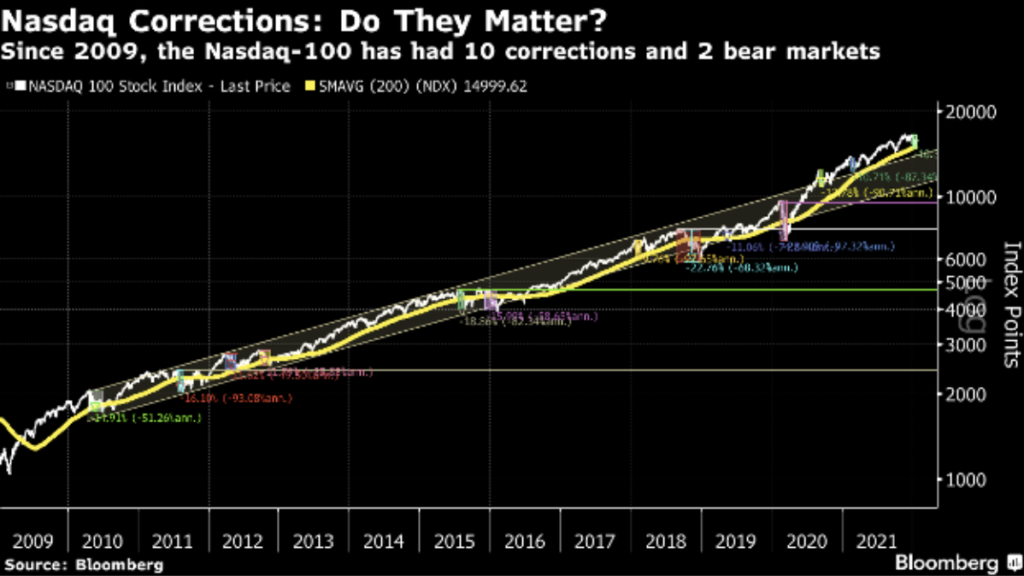Yesterday’s market moves could be well-characterized by one word: Wild. By early afternoon, all major indexes were approaching correction territory, trending down more than 10% from their recent highs. At some point, the Nasdaq was down almost 5% for the day, and the Dow Jones was down about 1,100 points. By closing time, all major indexes were up for the day.
Last week we observed something in reverse: Early gains in the indexes were being erased and then replaced by losses. Rising volatility exacerbates risks and increases nervousness. For the year, as the following graph shows, the losses range from 5.5.% for the Dow Jones to 11% for the Nasdaq.

We believe that the characterization (market epicureans vs. market stoics) we gave two weeks ago regarding the market’s trajectory (for the beginning of 2022), still stands. In that commentary, we presented the reasons and causes that made us cautious in the beginning of the year. The gyrations we are observing reveal the fact that in a normalized market of non-zero rates, weak balance sheets and especially unprofitable operations exhibit their nakedness. Therefore, as the Fed is forced to follow a less expansionary policy (which implies raising rates as well as shrinking its balance sheet), the market returns to more rational valuations, especially for weak companies. As the market retreats, even solid companies – whose fundamentals may reflect stock prices close to their fair value estimates – experience downward pressures. We are of the opinion that for the medium-term and long-term investor, those downward pressures present buying opportunities once the dust settles. Furthermore, the rising volatility may prove to be fertile ground for buying call options financed by the selling of put options, as long as the targeted company is solid and the investor desires to have those shares at the designated strike price.
In our January 10th commentary (see link above), we explained the reasons why such a market behavioral pattern could be expected. In today’s commentary, we summarize some facts which point to cautious steps and active management.
- Corporate earnings represent one of the most important factors (if not the most important) that determines market trajectory. Corporate earnings are strong and healthy, therefore we believe that claims for a market drop of 40%+ are exaggerated.
- Liquidity is ample (probably more than $2.5 trillion in M2) and financial conditions do not portray rising stress level. Therefore, we do not see a forthcoming credit crunch that would undermine expansion.
- Sales and growth rates are also healthy which, in turn, do not betray signs of recession. A slowdown in sales will allow the replenishing of inventories.
- Inflationary pressures are expected to subside in the second half of 2022 as wage growth decelerates and supply chain issues are addressed. This could also be seen in inflation forecasts that show that the inflation rate is anchored around 3% (please recall that we never adopted the transitory narrative).
- The pandemic’s impact will also decrease by the second half of 2022, and that will bring normalcy to PMIs and confidence indexes.
- As the air is coming out of over-valued securities and particular “asset classes”, a more rational market will prevail that will allow better reasoning to prevail.
- Even after ten corrections and two bear markets, the long-term perspective is uplifting, as shown below:

Based on the above and assuming that we adopt at least a medium-term perspective (18-30 months), we are of the opinion that even in a down market opportunities will surface. So, what could go wrong and where are the sources of potential major trouble?
At this point we could point to two external factors that could reverse the normalized trajectory we outlined above: First, a geopolitical turmoil instigated by dictators known for their deep-down insecurities of the likes of Putin and Xi. Second, a debt implosion in China. The following figures show that the overvalued Chinese real estate sector is following a crash trajectory, and therefore, we would not be surprised if the endemic problems of China and Russia morphed into a geopolitical conflict given their weak positions.

To close, allow me to share links to previous commentaries which elaborate on our position regarding those belligerent “leaders”:
